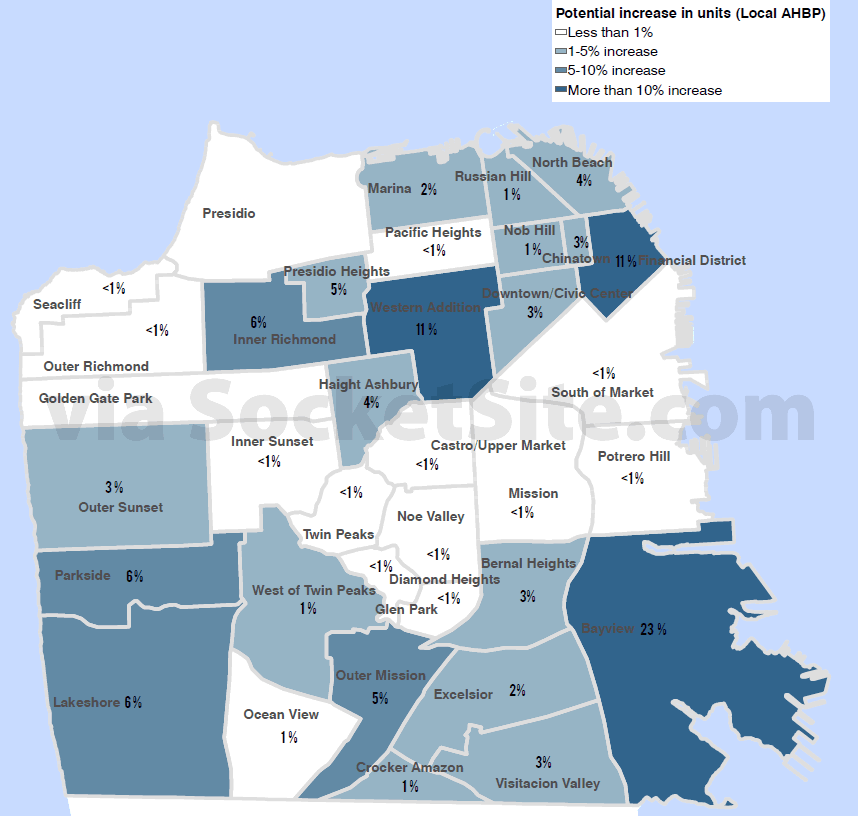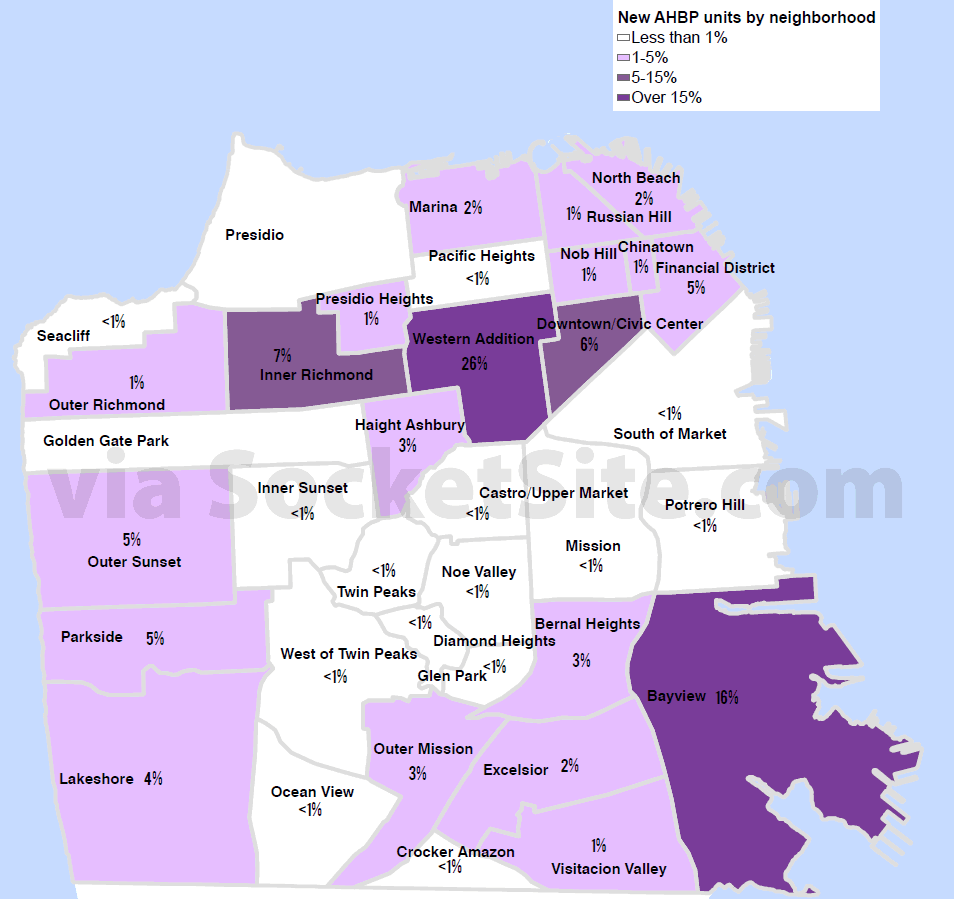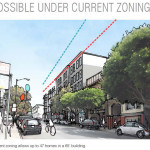San Francisco’s proposed Affordable Housing Bonus Program would allow developers in the city to build up to three stories higher than currently zoned, depending upon the percentage of ‘affordable’ units included on-site, the details for which we outlined in September.
If adopted by both the City and developers, the program would add the potential for building another 16,000 units of housing across city, an increase of roughly 4 percent over the 380,000 units that currently exist. But the distribution of those 16,000 units, as mapped above, would not be spread evenly across all neighborhoods.
And as mapped below, the relative impact, in terms of the percentage change in housing supply, would be skewed as well:
Originally scheduled for this afternoon, the Planning Commission’s public hearing and vote for the Bonus Program has been pushed back to the first week of December.
An illustration of what the AHBP could mean, in terms of design and density:




we could add 10,000 new units in Western SOMA alone if they would destroy that idiotic Western SOMA plan.
Which we could do. But we won’t. Because that would require someone doing something.
What part of the city do you live in “mayhem”?
Why exclude areas not zoned exclusively for SFHs or SFHs and 2-unit buildings?
I’m surprised SOMA is less than 1%. Parts of this area are zoned for mid and hi-rise buildings. I’d think developers of those buildings would be more apt to take advantage of this because of size. As opposed to say building to 5 stories on a site zoned for 2. The affordable housing component seems easier to deal with in terms of better penciling out on buildings with large numbers of units to begin with.
I’m assuming the added percentage of units is much greater going from (4) to (7) compared to (30) to (33).
That could be, but in a 30 story hi-rise you could be going from 300 units to 330 units.
So your 10% increase in SOMA, when applied to a three story (30 units) building would be a 200% increase when you add three floors (60). I don’t dispute it would be easier to add units, but when you only see increases in percentage you don’t see that.
I have done some cursory checking on this, with no results, but does anyone know if there is a restriction on the additional stories? The height of a floor can vary quite a bit, so I imagine there must be a limit to keep people from building to the previous max. height and then adding 45′ of extra height with those bonus levels.
I notice Lakeshore has a big jump. Its mostly single family with virtually no available open lots so I’m guessing the gain is coming from Park Merced?
Would their already approved massive project be allowed to go a bit higher if they met these revised standards?
Only other place I can see new building in Lakeshore are some of the lots behind The Galleria shopping center. Maybe Taraval, but does that count as Lakeshore?
The AHBP for “Lakeshore” (as the Planning Dept has defined it) is almost entirely Stonestown and some lots between SF State and Parkmerced. (see map in my namelink) It also includes some parcels along Sloat Blvd (which has a 100′ height limit) and Ocean Ave.
In line with my comments before, this seems and odd (and seemingly either ham-fisted or crony-based) allocation of increase – Inner Richmond up 6%, but Inner Sunset up less than 1%… and conversely Outer Richmond up less than 1%, but Outer Sunset up 3%?
Its hard to figure some of the numbers. Lakeshore seems high unless Park Merced is counted as potentially taking advantage of this.
Inner and Outer Richmond I don’t get.
Bayview? 23%. Yes there are more vacant lots there than probably anywhere in SF, but that much? Unless again, as with Lakeshore/Parkmerced, Lennar HP is expected to take advantage of this.,
I genuinely believe it’s more incompetence than corruption: the program is simply an overlay over existing zoning, which is arbitrary to begin with. If you look at the map (see my namelink), the program area is entirely made up of existing commercial/apartment building blocks. If they did anything other than an overlay, they’d have to have block-by-block justifications for each of their changes (one of the reasons why Western SOMA rezoning took so long and ended so badly.)
Here’s an idea – approve a Geary subway, and upzone the entire Geary corridor, with the tax increment allocated to funding a portion of the subway building costs. Nah, wait – that’s too sensible – let’s just spread out the increased density in a random and imprecise fashion.
Spot on. Building the Geary Subway and upzoning would make sense.
If I understand the ordinance correctly, it applies ONLY to lots zoned for 2-unit buildings or less, and ONLY to areas which do not already have an area plan. This is why it has no impact in SOMA, Mission, etc. And no application to lots zoned for mid- or high-rise buildings.
That’s half correct and partially backwards: “…the Bonus Program would not apply to projects in areas zoned for single-family or two-unit buildings or for parcels within neighborhoods for which an Area Plan…has already been adopted.” (See: Legislation To Allow Building Up To Three Stories Higher)
This makes sense – why the West of Twin Peaks gain is minimal. Like St. Francis Woods, Forest Hill, Westwood Park, Monterey Heights and even Miraloma Park and Mid-Town Terrace are going to allow multiple unit 6 story buildings?!
Why are there any areas still zoned for single-family?
In the 21st century, in major metropolitan centers like the Bay Area, there is absolutely no need for this relic of the post-war baby boom.
There is no good reason why any part of the city at all cannot or should not support multi-unit development.
So basically they’re admitting that the zoning is total BS, rather than being based on real valid concerns about neighborhood character, sustainability, or whatever it was supposed to be about.
Does anybody live in a building with a substantial number of “affordable” units that have been there a while? I’m interested in knowing how this arrangement works out over time when you have residents who may be substantially less affluent but who are equally impacted by increases in HOA fees, special assessments and so on.
Living in a condo unit isn’t just about buying it. As a matter of fact, my own building is now to the point where my HOA monthly assessment will, in the foreseeable future, exceed my mortgage payment.
I’m in a complex that is part of the MOH 2nd loan program, so there is a preference for income qualified first-time homebuyers, but the units are sold on the open market with the city have a right of substitution (which is unlikely to be exercised anymore since the prices are such that anyone currently qualifying for the program would be unlikely to be able to afford one of the units). But some of the longer term residents originally qualified for the program.
Our board is very conscious of the fact that many of the residents are sensitive to the HOA dues increases and do a pretty good job of keeping them to a minimal level while still keeping up on the maintenance and in eight years we have had only one special assessment which was just a few hundred dollars per unit. Probably a bit different of a situation though from a complex where the majority of units were sold as “luxury” while a few were subject to income limits.